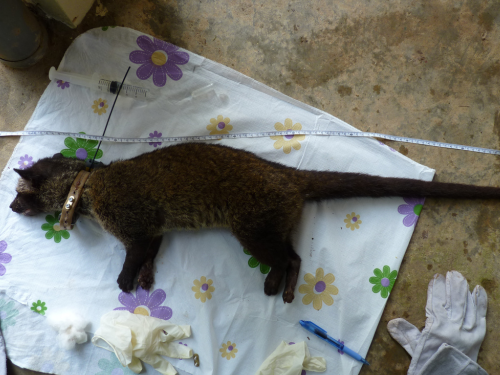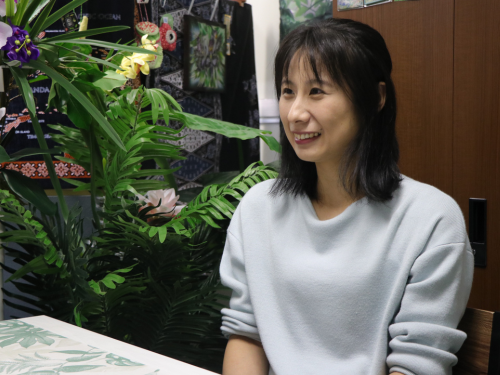By Hiroshima University Department of Public Relations
Out of this living laboratory emerged unexpected insights on coexistence from an “unusual” source.
Wildlife ecologist Miyabi Nakabayashi in her jungle-themed faculty office (Hiroshima University/Public Relations Office)
For some scientists, a typical workday means stepping into the laboratory. For wildlife ecologist Miyabi Nakabayashi, it means stepping out. The Bornean jungle is her living laboratory. And in it, workplace hazards can mean encounters with venomous snakes and saltwater crocodiles or bites from bugs and bloodsuckers.
“One time I had 50 leeches on my feet,” Nakabayashi, associate professor at Hiroshima University's Graduate School of Integrated Sciences for Life, said. She showed marks where mosquitoes and sand flies bit her and left scars.
“I may have been bitten by over 50,000 mosquitoes. I’m lucky I’ve never gotten malaria or dengue all these years.”
Work usually means staying for 22 hours in the jungle, shifting around a weighty antenna to get a signal on the whereabouts of radio-collared wildlife, collecting fecal samples from treetops, or staking out behind thickets. Her many tools include machetes, some of which have grips she fashioned after the katana. Nakabayashi took out her book to show us a photo of what it's like for a typical workday. After a few flips of the pages, appeared a photo of two glowing orbs amid the pitch-black night. To some, these could elicit fear but for her, it’s pure excitement. In the photo was a civet cat.
For nearly two decades she has been researching mammalian ecology, specifically their behavior and role in seed dispersal. And civets are her particular focus.
“I loved animals since I was a child. But maybe the most impactful event was when I was a high school student. I went to Borneo. It was a special event held by a museum in Kyoto Prefecture,” she said.
The selection was competitive but she was one of around 30 elementary to high school students chosen to take part. There, she saw a civet for the first time.
“It looked like the typical carnivore, but it was eating fruits high up on the tree, maybe about 30 meters from above the ground. I found that strange. I was fascinated by it,” she said. “So I got many questions. I learned there are eight civet species on Borneo island. So how do they coexist in the Borneo jungle? I had so many questions.”

A radio-collared civet cat (Courtesy of Miyabi Nakabayashi/Hiroshima University)
Since then, she’s been studying civets to find an answer to a longstanding ecology question. How do similar species coexist in the same habitat despite having overlapping resource needs?
A masterclass on coexistence
When two species occupy the same niche, the competitive exclusion principle states that the one with advantageous traits will eventually outcompete and displace the other. But in nature, there are many examples of species coexisting instead of driving competitors towards extinction.
Ecologists have long been interested in uncovering what enables wildlife to thrive together. Its understanding could inform biodiversity management and conservation efforts.
One way that wildlife negotiates coexistence is by niche partitioning — using a resource or habitat otherwise neglected by other competing species. Niche partitioning strategies such as avoiding periods when competitors are most active (temporal niche partitioning) or making use of an underexploited portion of a shared food (dietary partitioning) have been observed by Nakabayashi in the Bornean jungle.
In 2021, she and her co-researchers unveiled findings from over three years of observing Borneo’s mammalian carnivores such as civets, sun bears, wild cats, and otters. They found that some carnivores strategically avoid each other by adjusting their hunting schedules, helping reduce rivalries over resources within their shared habitat.
A year before, Nakabayashi published results from her eight-year study of four Paradoxuriane civet species inhabiting overlapping domains. All four species depend on a diet of figs and fruits of pioneer plants. However, if these are scarce, they diversify their food choices by eating plant parts other than the fruit. Previous reports showed they also snack on flowers or slurp nectar and tree sap. Usually, immature and unripe fruits are avoided as they are nutrient-poor, difficult to digest, and often laced with toxic or distasteful compounds. However, Nakabayashi found that small-toothed palm civets also feed on immature and unripe fruits despite not having a specialized stomach to digest them. Such slight differences in food choices and behavior help explain how multiple species can live together in the same habitat without excluding each other.
Animal miniatures and books about Borneo inside Nakabayashi's faculty room. (Hiroshima University/Public Relations Office)
Agriculturists of the jungle
Nakabayashi also found that civets are master agriculturists. Her study showed that the defecation behavior of binturongs, a large stocky civet, plays a crucial role in the dispersal and establishment of hemi-epiphytic figs, a crucial food source for many creatures in the Bornean jungle. She received the 24th Kira Award for Young Scientist from the Japan Society of Tropical Ecology for this research.
Out of the animals that feed on these figs, she noticed that binturongs deposit their seed-speckled droppings on specific microsites most suitable for these plants to successfully establish themselves.
She also found that binturongs may remember the fruiting period of fig trees they visit. And like farmers planning around harvest, they seem to pattern their movements around figs’ fruiting season. She was granted the award for young researchers by the Mammal Society of Japan this year for her series of studies on civets.
Amid threats to wildlife such as climate change and deforestation, Nakabayashi’s years of fieldwork made her witness nature’s remarkable resilience.
“Nature's resilience and strength are greater than what people might think,” she said. “However, overexploitation by humans definitely deteriorates and destroys forest ecosystems. We need to reconsider the balance of our activity to live in the ecosystem that is formed over hundreds and thousands of years.”
Nakabayashi admits more research is needed to answer the coexistence question. There is much to learn about harmonious coexistence from civets and yet we have barely scratched the surface.
(Research news authored by Mikas Matsuzawa)
Media Contact
Inquiries on the study
Miyabi Nakabayashi
Associate Professor, Hiroshima University Graduate School of Integrated Sciences for Life
E-mail: nmiyabi * hiroshima-u.ac.jp
(Note: Please replace * with @)
Inquiries on the story
Hiroshima University Public Relations Office
TEL: 082-424-3701
E-mail: koho * office.hiroshima-u.ac.jp
(Note: Please replace * with @)

 Home
Home

















